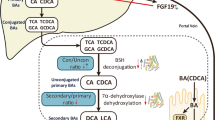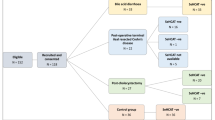Abstract
This study evaluated the efficacy of measuring urinary sulfated bile acids (USBA) for diagnosis of bacterial cholangitis in patients with biliary atresia. Eight infants with biliary atresia were recruited. The USBA level was measured when they were admitted to hospital with a fever of unknown origin. Clinical manifestations and laboratory data were reviewed. The standard USBA value for each patient (S-USBA) was defined as the level measured when they had no fever, and USBA ratio (R-USBA) was calculated as the USBA level during the febrile episode divided by the S-USBA. Then R-USBA values were compared between febrile episodes with and without cholangitis to assess the diagnostic ability of USBA. Twenty-three febrile episodes occurred in eight patients during a 15-month period. Nine episodes were diagnosed as being due to cholangitis, five were due to non-cholangitis, and nine were of undetermined origin. The R-USBA value ranged from 1.5 to 15.4 during cholangitis episodes and from 0.4 to 1.2 during non-cholangitis febrile episodes. When fever was of undetermined origin, R-USBA was found to be increased during some episodes and not in others. USBA increased immediately in patients with cholangitis. The measurement of USBA is a useful non-invasive test for cholangitis in patients with biliary atresia who had undergone Kasai’s operation.
Similar content being viewed by others
Avoid common mistakes on your manuscript.
Introduction
Ascending bacterial cholangitis is a major management problem in patients with biliary atresia after hepatic portoenterostomy. Early treatment is very important because bacterial cholangitis may aggravate cholestasis and worsen liver function, accelerating progression to cirrhosis. However, the diagnosis is often empirical and it is not always easy to detect cholangitis accurately and promptly.
It is known that urinary excretion of sulfated bile acids (USBA), which are water-soluble, increases as an alternate metabolic pathway in patients with cholestasis [1–3]. Accordingly, we investigated the efficacy of measuring USBA for the early diagnosis of cholangitis in patients with biliary atresia.
Materials and methods
From November 2001 to March 2003, 18 infants underwent surgery for biliary atresia at Kobe Children’s Hospital. Eight of these patients were admitted to the hospital with cholangitis after Kasai’s operation between May 2002 and March 2004, and were recruited for this study. The USBA level was measured each time when they were admitted with fever. Clinical manifestations and laboratory data were reviewed, including the complete blood count, C-reactive protein (CRP), serum bilirubin, and hepatic enzymes [glutamic-oxaloacetic transaminase (GOT) and glutamine pyruvic transaminase (GPT)].
A diagnosis of cholangitis was made on the basis of otherwise unexplained fever (>38°) associated with elevated serum CRP and an increase of serum bilirubin. Febrile episodes without cholangitis were due to upper respiratory tract infection, enterocolitis, influenza, and/or fever after endoscopic sclerotherapy. When the source of infection was unidentified and there was no increase in serum bilirubin, this was defined as fever of undetermined origin.
About 5 ml of urine was obtained from each patient. The measurement of USBA was performed by enzymatic assay at a contract laboratory (FALCObiosystems Co., Ltd., Kyoto, Japan). The standard USBA value (S-USBA) of each patient without jaundice was defined as the minimum USBA level measured when they had no fever. In icteric infants, S-USBA level was defined as the level measured while temperature and liver function were stable within a few weeks before or after a febrile episode because the value was dependent on the degree of cholestasis. The USBA ratio (R-USBA) was calculated as the USBA level at the time of a febrile episode divided by the S-USBA value.
Results
Five of the eight patients had no jaundice and the remaining three suffered from jaundice (cases #6, 7, 8). Twenty-three febrile episodes were documented in these eight patients during the 15-month study periods. Nine episodes were due to cholangitis, five episodes were definitely not due to cholangitis, and the remaining nine episodes were fever of undetermined origin. The data from the episodes of cholangitis, non-cholangitis fever and undetermined fever are summarized in Tables 1, 2, and 3, respectively. R-USBA ranged from 1.5 to 15.4 during episodes of cholangitis (Table 1). In three of the nine episodes, USBA was elevated 2 days before the elevation of total bilirubin (episodes No. 2, 3, and 7). The cause of fever and the USBA levels during the non-cholangitis episodes are summarized in Table 2. During the non-cholangitis episodes, R-USBA ranged from 0.4 to 1.2 (Table 2). In episodes of undetermined fever, R-USBA ranged from 0.3 to 4.8 (Table 3).
When the cut-off value of R-USBA was set more than 2.0, the sensitivity, specificity, and positive and negative predictive values of this test was 66.7, 100, 100 and 62.5%, respectively, for the diagnosis of cholangitis (Table 4).
Discussion
Cholangitis has been one of the most important and difficult sequelae to manage after Kasai’s portoenterostomy for biliary atresia. It has been reported that 33–90% of patients with biliary atresia experience at least one episode of cholangitis [4–6]. Pediatric surgeons are very sensitive about febrile episodes in patients with biliary atresia because cholangitis can lead to obstruction of bile flow and deterioration of liver function. Early treatment, including nil orally and intravenous antibiotics, is required for the successful management of cholangitis in order to minimize adverse effects on the liver. However, it is not always easy to make a prompt and an accurate diagnosis of cholangitis, since there are no fixed diagnostic criteria. Although it is generally considered that cholangitis is characterized by unexplained fever with elevation of CRP and jaundice (or acholic stools) [6–8], the increase of CRP is well known to be delayed by 24 h or so and the serum bilirubin level does not necessarily increase. In three of the nine episodes of cholangitis in this series, USBA increased 2 days earlier than the elevation of total bilirubin. Although blood culture can directly detect the organism causing cholangitis, the rate of positive blood cultures is low [6, 9]. Some authors have proposed the efficacy of liver biopsy [10, 11], but such a procedure is clearly too invasive when measurement of USBA is simple and only requires a urine sample.
Sulfated bile acids have a high water solubility and are immediately excreted into the urine if the serum concentration of these bile acids increases sufficiently. We demonstrated that the USBA level showed an immediate increase in patients with cholangitis. The mechanism of the increase of USBA in cholangitis is thought to be an obstruction due to inflammatory cell infiltration around the intrahepatic bile ducts. As a result, excretion of bile from hepatocytes into the bile canaliculi and drainage of bile are impaired, and cholestasis occurs. Cholestasis increases the serum bile acid level and renal excretion, as USBA occurs.
We demonstrated that the R-USBA value increased immediately in cholangitis, but not in non-cholangitis. However, in the treatment of febrile episodes in postoperative patients, the biggest problem is how to manage an undetermined fever. Most of pediatric surgeons treat such episodes as suspected cholangitis; i.e., hospitalization and intravenous administration of antibiotics with nil orally are done empirically. Such treatment is not only costly but also decreases the quality of life of patients.
The R-USBA value was variable in the undetermined fever group in this study. The episodes of increased R-USBA showed that cholestasis could occur when the body temperature rose. However, conventional tests such as total bilirubin did not reveal cholestasis. It is possible that these were episodes of cholangitis with cholestasis. On the other hand, the febrile episodes without an increase of R-USBA were not associated with cholestasis and were unlikely to be cholangitis. For example, in febrile episodes no. 17 and 18, the hepatic enzymes were elevated more than twice their usual value (GOT/GPT = 161/205 and 286/233, respectively) without elevation of serum total bilirubin. It is very difficult to determine whether these two febrile episodes were due to cholangitis or non-cholangitis. However, R-USBA showed cholestasis, so these two febrile episodes may be considered as cholangitis.
There are some problems with using the measurement of USBA as a test for cholangitis. Firstly, in biliary atresia patient, the standard USBA level cannot be determined because it fluctuates with potential associated cholestasis. For this reason, the R-USBA value was used in the present study. Secondly, fever associated with cholestasis does not pathopysiologically correspond to cholangitis. To solve this problem, a prospective study using USBA to detect cholangitis is necessary in the future.
In conclusion, measurement of USBA is a helpful and non-invasive diagnostic test for postoperative cholangitis in patients with biliary atresia and could be included in the routine work-up for suspected cholangitis.
References
Makino I, Hashimoto H, Shinozaki K, Yoshino K, Nakagawa S (1975) Sulfated and nonsulfated bile acids in urine, serum, and bile of patients with hepatobiliary disease. Gastroenterol 68:545–553
Obatake M, Muraji T, Satoh S, Nishijima E, Tsugawa C (2002) Urinary sulfated bile acids: a new simple urine test for cholestasis in infants and children. J Pediatr Surg 37:1707–1708
Muraji T, Harada T, Miki K, Moriuchi T, Obatake M, Tsugawa C (2003) Urinary sulfated bile acid concentrations in infants with biliary atreisa and breast-feeding jaundice. Pediatr Int 45:281–283
Japanese Biliary Atresia Society (2000) Nationwide Registry of Biliary Atresia, 1998. Jap J Pediatr Surg 36:348–353
Ernest Van Heurn LW, Saing H, Tam PKH (2003) Cholangitis after hepatic portoenterostomy for biliary atresia: a multivariate analysis of risk factors. J Pediatr 142:566–571
Wu ET, Chen HL, Ni YH, Lee PI, Hsu HY, Lai HS, Chang MH (2001) Bacterial cholangitis in patients with biliary atresia: impact on short-term outcome. Pediatr Surg Int 17:390–395
Bu LN, Chen HL, Chang CJ, Ni YH, Hsu HY, Lai HS, Hsu WM, Chang MH (2003) Prohylactic oral antibiotics in prevention of recurrent cholangitis after the Kasai portoenterostomy. J Pediatr Surg 38:590–593
Rothenberg SS, Schroter GPJ, Karrer FM, Lilly JR (1989) Cholangitis after the Kasai operation for biliary atresia. J Pediatr Surg 24:729–732
Gottrand F, Bernard O, Hadchouel M, Pariente D, Gauthier F, Alagille D (1991) Late cholangitis after successful surgical repair of biliary atresia. Am J Dis Child 145:213–215
Ecoffey C, Rothman E, Bernard O, Hadchouel M, Valayer J, Alagille D (1987) Bacterial cholangitis after surgery for biliary atresia. J Pediatr 111:824–829
Tagge DU, Tagge EP, Drongowski RA, Oldham KT, Coran AG (1991) A long-term experience with biliary atresia. Reassessment of prognostic factors. Ann Surg 214:590–598
Author information
Authors and Affiliations
Corresponding author
Rights and permissions
About this article
Cite this article
Shinohara, T., Muraji, T., Tsugawa, C. et al. Efficacy of urinary sulfated bile acids for diagnosis of bacterial cholangitis in biliary atresia. Ped Surgery Int 21, 701–704 (2005). https://doi.org/10.1007/s00383-005-1493-7
Accepted:
Published:
Issue Date:
DOI: https://doi.org/10.1007/s00383-005-1493-7




